Sri Lanka Birds
This section features over 30 species of birds commonly found in Sri Lanka.

Indian Myna near homes in Kandy |
After spending months in eastern Indonesia with its relative dearth of birds (at
least in the area we were in) it was fantastic to spend time
with some of the wonderful birds of the Indian Sub-continent. Sri Lanka
has over 400 species of birds, with some 25 of them being endemic (found nowhere
else), and others found only in Sri Lanka and India.
For identification we mainly used two books: A Photographic Guide to the Birds of
India and Nepal by Bikram Grewal (New Holland Publishers, London 1995) and
Birds of India by R. Grimmet, C. Inskipp, T. Inskipp (Princeton
University Press, 1999). If you want specific books on Sri Lanka's
birds you might look for these titles: A Field Guide to the Birds of Sri
Lanka by John Harrison or A Photographic Guide to the Birds of Sri
Lanka by Wijeyeratne, Warakagoda and de Zylva.

Sue birding in Yala National Park |
Although the original enthusiasm for birding came from Sue, Amanda is now
almost equally interested and has become the family's
primary bird photographer. The latter may have to do with the new camera:
Amanda is in love with our Canon SLR Rebel XT (digital) with
its long, Image Stabilized zoom lens, and its immediate shutter response. No more lag
between pressing the button and getting the shot like we had with our much less
expensive digital cameras which allowed the birds time to fly away. But
birding isn't all about photography -- in fact the majority of birds we see and
identify are seen only through binoculars. The advantage of getting a
photograph, (even a poor one) is that one can sit quietly and study the bird,
comparing it to illustrations in bird books, to get an accurate ID. A good
photo, of course, is magic!
All photos were taken in the wild, mostly in Yala National Park, with
credit/copyright Amanda Hacking 2007,
unless otherwise noted.
The birds shown below are:
No listing of birds of the Indian sub-continent would be
complete without a ubiquitous Indian or Common Myna Acridotheres tristis
(above, at top). We first encountered this bird in the islands of Fiji in the
central Pacific Ocean, then again in Australia, Indonesia, and SE Asia. This is
a brownish bird with black head, neck and breast, a yellow-orange bill, yellow
orbital skin (the skin around the eye) and yellow legs. In flight the under
wings are conspicuously white, with a white tail tip. Noisy and
gregarious, these are probably the most commonly seen and heard birds throughout
the country. Indian Mynas nest in holes in large canopied trees, often
communally with crows, returning to the same trees for many generations.
They are opportunistic feeders, living happily off household scraps, nectar,
fruits, large insects such as grasshoppers, geckos and other small lizards.
They can be found just about anywhere, especially near human habitation.
 |
Camouflaged nicely into the brown and green grassland, the small
(19 cm or 7 inches) Indian Pitta Pitta brachyura can be hard to
spot. It remains silently feeding on the ground until alarmed at
which time it will fly into the always nearby shelter of bushes or
trees. When it does call it makes a sharp dual-noted descending
whistle. The Indian Pitta is a resident of India and the
Himalayas but migrates to Sri Lanka in the winter. |
| Perched in the branches of a beach Scaveola bush, we saw this stout
female Orange Breasted Green Pigeon Treron bicincta in
Yala National Park. The male has similar gray tail feathers and
green back with dark gray wing tips but with a lavender band below the
throat and a broad orange patch on the upper breast. These pigeons
are resident in Sri Lanka and neighboring India and the Himalayas.
They prefer moist subtropical broadleaved forest and are fruit eating. |
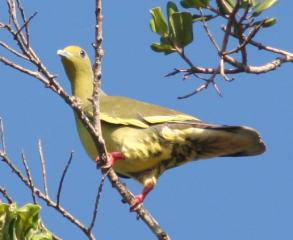 |

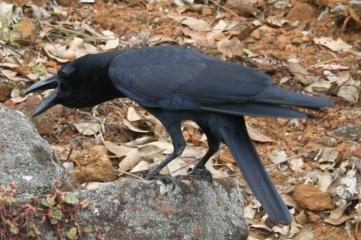
High in the tea fields of central Sri Lanka a Jungle, or
Large-Billed Crow Corvus macrorhynchos hopped about between
tea plants. These large dark crows are found where ever there are
people, always on the look-out for scraps of food. They are aggressive,
and will attack even larger animals for food or to protect their young.
They make more of a croaking, than a cawing sound, and nest in large
colonies, often for many generations. (Sri Lanka tea fields, Haputale) |
| On one of the lawns in the Peradeniya Botanic Garden near Kandy we
came upon a lovely Red-wattled Lapwing Vanellus indicus.
Part of the plover family, this bird is seen fairly commonly near cities
and in fields. It is strikingly colored with its black head, neck
and breast, with white band on the side neck and red wattle (which gives
it its name), white belly and tan back. We used the telephoto lens
to "get close" to the bird which was obviously distressed to have anyone
walking near it. On closer examination we could see one tan and
gray-speckled egg in the grass under the bird. Lapwings eat
insects, seeds and tubers, and are usually found in pairs. (Peradeniya
Botanic Garden, near Kandy) |
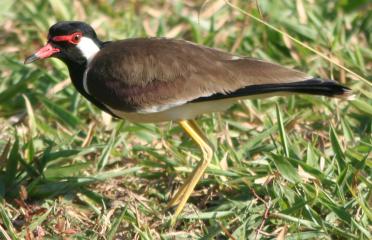
A Red-wattled Lapwing stands guard over its egg. |
|
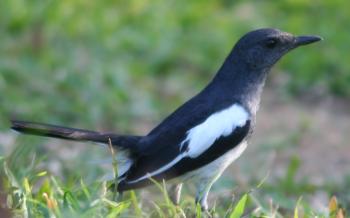 |
The Magpie Robin, also known as the Oriental Magpie Robin
Copsychus saularis is a very common bird in Sri Lanka and
neighboring India. Found in gardens, parks, woodlands and open
forest it often announces its presence with a lovely "swee-ee"
song. The female is similar to the male although the black back,
head and tail may appear more gray. It is often seen on the
ground, hopping about for insects. (Peradeniya Botanic Garden,
near Kandy) |
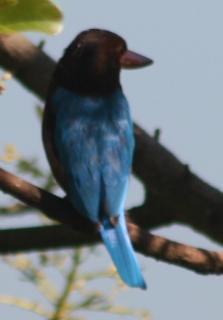
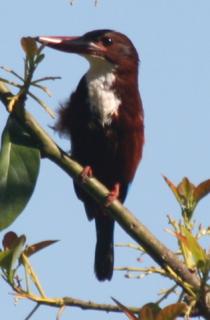
One of the most commonly seen kingfishers in Sri Lanka is the
White Breasted or White Throated Kingfisher Halcyon
smyrnensis. Less dependent on nearby water than most
kingfishers, the White Breasted hunts from tree branches or wires,
swooping down on small lizards, insects, frogs and sometimes fish.
Its large (in this case red) bill is characteristic of kingfishers.
It has chocolate brown plumage on its head and chest, with a large white
breast. Its back is a brilliant sky-blue. Like its large
relative, the Kookaburra in Australia, it emits a laughter-like call.
We saw this kingfisher in the highlands near Kandy, on the SE coast in
Yala National Park, and in the suburbs north of Colombo. (Kandy) |
| The repeated "towit towit" and "keea keea" alerted us to
look for the bird making the lovely call. Amanda spotted the
sparrow-sized Common Tailorbird Orthotomus sutorius on a
branch outside our guesthouse in Kandy. When singing, the Common
Tailorbird shows a black necklace (barely visible in this photo) that
separates its rufous head from its yellow-green back, and making a
striking line in its white chin and belly. It would have been
great to see the nest of this small bird, because it is unique in that
it consists of two or more living leaves sewn together to create a pouch
for the eggs, giving the bird its name "tailorbird".
(Kandy) |
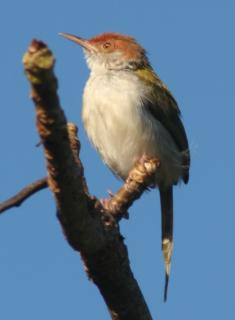 |
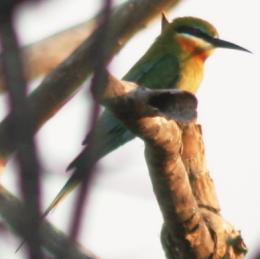 |
We saw the chestnut-chinned Blue-Tailed Bee-eater Merops
philippinus in light wooded areas of Yala National Park and again
north of Colombo outside the suburbs. Even with poor lighting the
upright stance, long tail and long down-curved bill gives you the jizz
of a bee-eater. When sun hits the ird you can then distinguish the
colors and the species. Although we only caught a glimpse of the blue
tail of the Merops phillipinus the rufous chin and green head
were enough to give us an ID. Our field guide does not mention the
white streak beneath the black mask which appears so prominently in our
photo. Bee-eaters are gregarious, often perching together in open
branches or on wires from which they swoop off to feast on flying
insects. They are about 23‑26 cm (8‑10 inches) from head to tail tip. |
| Smaller than the Blue-tailed Bee-eater, is the more commonly seen
Green Bee-Eater Merops orientalis. this gregarious brightly
colored bird may appear green all over, or, in the right light, show off
its blue throat, black band between throat and belly, and chestnut
crown. Both male and female have elongated pin (central tail)
feathers although at times an individual may not. Like other
bee-eaters, they perch and roost communally, taking winged insects as
prey. We saw them repeatedly throughout Sri Lanka in wooded areas,
near homes, in the hills and on the coast. |
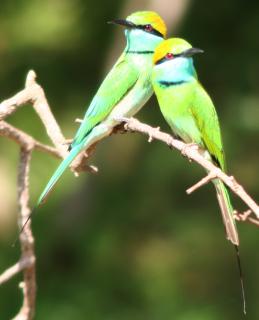 |
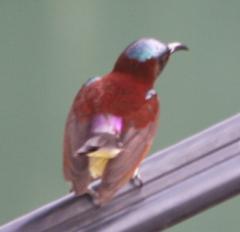 |
Fussing about the many flowering plants of open forests and gardens
in Sri Lanka was the Purple Rumped Sunbird Nectarinia
zeylonicca. The male is distinctive with a black down-curved
beak, maroon rump, yellow breast, metallic green head and chestnut back.
The female is less colorful. These birds can hover above flowers
or perch on the delicate edges to sip nectar with their down-curved
beaks. The call can be a metallic "chit" or a repetitive
"ptsee-ptsee". (Kandy) |
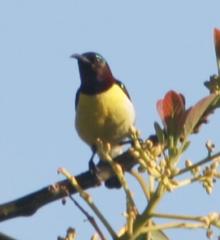 |
| On the edge of a lowland forest in Yala National Park we saw this
lovely green and yellow, red-billed, mid-sized (42 cm or 17 inches) parakeet
in the branches of a beach Scaveola tree. The Rose Ringed
Parakeet Psittacula krameri, so named for the male's pale
rose colored collar, is the most common parakeet in the Indian
Sub-continent. They can be found in open forest, fields, gardens
and cities and although they are mainly arboreal they will come down
into fields to feed on ears of corn. At night they roost in huge
flocks in the tree tops. Their call is a harsh "kree-kree". |
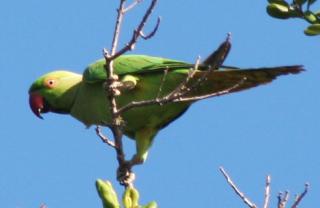 |
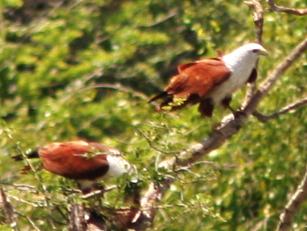 |
From the sea coast to the hills of Sri Lanka, but never far from
water, you may see the handsome Brahminy Kite Haliastur indus.
The rich chestnut brown of the back contrasts well with the bright white
of the head, neck, upper back and breast. In flight the white
breast stands out next to the chestnut tail and wings, along with black
wing tips. Juveniles are brown streaked overall. Brahminy
Kites are about medium size in the raptor range, at about 48cm (19in).
They feed on fish, crabs, frogs and even small birds. Their call
is two-part: "tssss herheheheheheheh" or a drawn out sound "kyeeeeerh". |
| For such a large bird, its hard to believe how easily this
Malabar Pied Hornbill Anthracoceros coronatus managed to
blend itself into the surrounding branches. The largest of the
hornbills found in Sri Lanka, the Malabar Pied Hornbill has a unique
casque in that it is ax-shaped, with a dark path on the upper half.
This photo could be of either a male or female, but since we can't see
the posterior end of the casque we can't tell. (The male's has a black
band, the female's does not.) These hornbills have black bodies
with white outer tail feathers, with a white trailing edge to the wings.
They can be found near inhabited areas and open forest. |
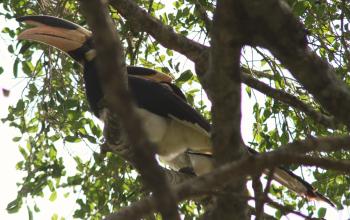 |
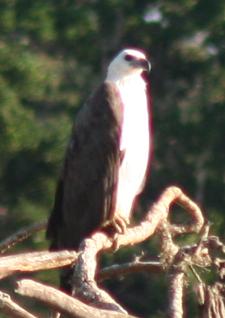 |
Found along the sea coasts of India and the whole perimeter of Sri
Lanka, the majestic White Bellied Sea Eagle Haliaeetus
leucogaster is frequently seen soaring over the water in search of
fish, or perched nearby, eyes alert for action on the water. When
gliding, the White Bellied Sea Eagle carries its wings in a distinct V‑shape,
and its white belly, head and white under-wing coverts contrasts
sharply with the black wing remiges (the trailing edges). These eagles
are often seen in pairs. They feed on fish and sea snakes. |
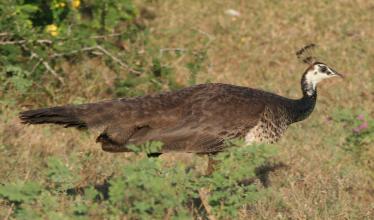
 Lured by the majestic display of a male Indian Peafowl
Pavo cristatus an interested hen (left) approaches in
Yala National Park. Although Peafowl have been introduced to many parts
of the world, here in Sri Lanka they still wander at will,
undomesticated and untamed in woodlands and forest. Peafowl rely more
on their legs than their wings to escape danger but do fly. In
fact they roost at night in trees where their large bodies appear ungainly
on small tree branches. Their call is a very loud "may-aw".
Lured by the majestic display of a male Indian Peafowl
Pavo cristatus an interested hen (left) approaches in
Yala National Park. Although Peafowl have been introduced to many parts
of the world, here in Sri Lanka they still wander at will,
undomesticated and untamed in woodlands and forest. Peafowl rely more
on their legs than their wings to escape danger but do fly. In
fact they roost at night in trees where their large bodies appear ungainly
on small tree branches. Their call is a very loud "may-aw". |
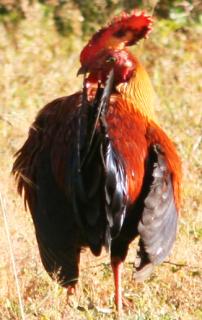 |
Shown here walking away, but looking back over its rich black and red plumage,
is Sri Lanka's national bird, and it is no ordinary farm rooster. The wild,
large Sri Lanka Junglefowl Gallus lafayetii is a handsome
bird found throughout most parts of Sri Lanka except the SE (more
inhabited) corner of the island. A member of the pheasant family,
the Sri Lanka Junglefowl has purple-black tail and wings, an orange spot
on the red comb and elongated reddish-orange feathers over the back.
The female is less strikingly colored, with black and white patterning
on the breast. |
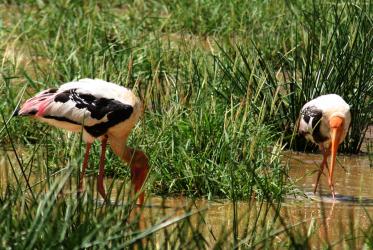
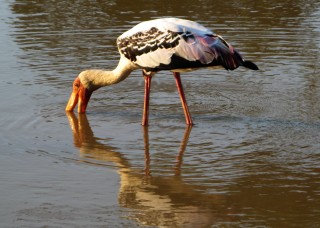 Probably the most beautiful of Sri Lanka's storks is the colorful
Painted Stork Mycteria leucocephal with its yellow, slightly
downcurved bill, coral-pink face and legs and black and white body with
pink tail feathers. Found in fresh water habitat throughout India and
Sri Lanka these large (93 cm or 34 inches) storks probe the silty, muddy
bottoms of marshes and ponds for frogs, mollusks and crabs.
Probably the most beautiful of Sri Lanka's storks is the colorful
Painted Stork Mycteria leucocephal with its yellow, slightly
downcurved bill, coral-pink face and legs and black and white body with
pink tail feathers. Found in fresh water habitat throughout India and
Sri Lanka these large (93 cm or 34 inches) storks probe the silty, muddy
bottoms of marshes and ponds for frogs, mollusks and crabs. |
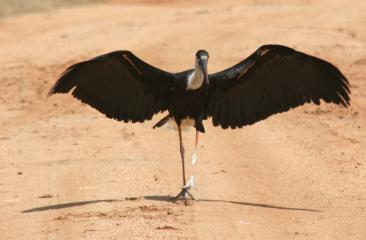
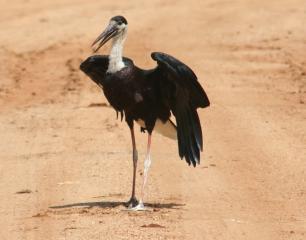 Yala National Park is a fantastic place for viewing some of Sri
Lanka's 5 species of stork. Strutting along the road was a small
flock of Woolly Necked Storks (also known as White Necked Storks)
Ciconia episcopus. These large storks (up to 92 cm or 33 inches
tall) have black bodies with white "woolly" necks, black caps, bills and
wings, with red legs. They are not very gregarious, nor noisy. The
main sound they make is the sound of their mandibles clacking when their
heads are thrown back. They, like other storks, often soar on thermals.
Yala National Park is a fantastic place for viewing some of Sri
Lanka's 5 species of stork. Strutting along the road was a small
flock of Woolly Necked Storks (also known as White Necked Storks)
Ciconia episcopus. These large storks (up to 92 cm or 33 inches
tall) have black bodies with white "woolly" necks, black caps, bills and
wings, with red legs. They are not very gregarious, nor noisy. The
main sound they make is the sound of their mandibles clacking when their
heads are thrown back. They, like other storks, often soar on thermals. |

 The Asian Openbill Stork is one of the smallest, but most
unusual of Sri Lanka's storks. It has an overall white plumage
(grayish when non-breeding) with black flight feathers, pale pink legs,
a gray head and a long gray bill that closes with a long gap (hence the
name "openbill"). Like other storks it makes large messy nests (left) in
trees, usually communally. After breeding these communities tend
to disperse. Openbills feed on frogs (right), mollusks and crabs.
The purpose of the gap in the closed mandibles is not known.
The Asian Openbill Stork is one of the smallest, but most
unusual of Sri Lanka's storks. It has an overall white plumage
(grayish when non-breeding) with black flight feathers, pale pink legs,
a gray head and a long gray bill that closes with a long gap (hence the
name "openbill"). Like other storks it makes large messy nests (left) in
trees, usually communally. After breeding these communities tend
to disperse. Openbills feed on frogs (right), mollusks and crabs.
The purpose of the gap in the closed mandibles is not known. |
| Although a bit far away to see real detail, we were very lucky to
spot one of the two pairs of Black Necked Storks Ephippiorhynchus
asiaticus that reside in
Yala National Park, in SE Sri Lanka. These relatively large (up to
150 cm or 60 in) storks reside throughout much of the lowlands of India
and Sri Lanka, but are becoming more and more rare. Unfortunately,
they are not a protected species, and we couldn't find any information
on why they are not very often seen anymore. Like other storks
they soar on thermals, then come to fresh water to feed on frogs,
insects, fish and small lizards. The Black Necked Storks are seen mainly
in pairs and are wary. They have a black neck, bill, head and
tail, and in flight they display a broad black band across the otherwise
white wings. |
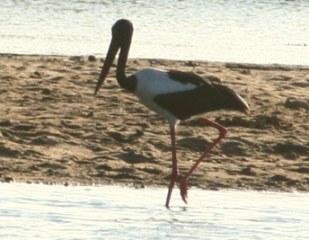 |
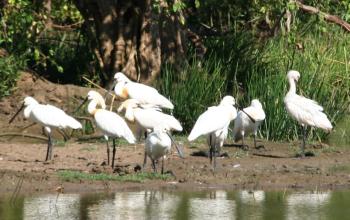 |
Unique in appearance is the Eurasian or White Spoonbill
Platalea leucorodia with its long black, flat bill ending in a
broad "spoon" shaped tip which may appear yellow. Adult birds are
all white except in breeding season when then develop a yellowish white
crest, a red patch at the base of the throat and a beige "necklace".
In the photo, some of the birds have breeding plumage, and some do not.
Spoonbills are found throughout India and Sri Lanka near rivers,
lakes and marshes. They feed by moving their bills in the water
while opening and closing them. They eat both plants and small
animals. |
| The Indian Pond Heron Ardeola grayii is a widespread
resident throughout most of India and Sri Lanka. In flight is appears
two-tone with white wings and a buff-colored back. The photo
(right) shows the non-breeding plumage. In breeding season, the
adult has a more yellow head and neck and maroon-brown back. One of the
smallest herons (42‑45cm or 17‑18in) this bird is found on both inland
and coastal areas --anywhere with water, be in natural or man-made. IN
fact it has taken so well to rice paddies, it is colloquially known as
the Paddybird. Like other herons, it poises in the water,
alert, attentive, until it suddenly strikes out for its food of frogs,
insects, or small fish. |
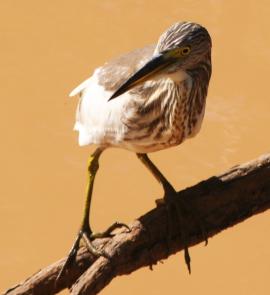 |
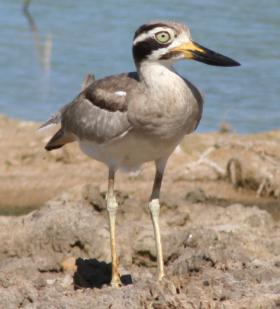 |
A member of the plover family, the Great Thick-knee Esacus
recurvirostris (literally "re-curved nose") is commonly seen on the
rocky, sometimes sandy, edges of lakes, river banks, and coastal shores.
This is a tall wader (49‑54cm or 20‑22 in) with striking facial
markings: strong black and yellow upturned bill, gray head with white
"spectacles" and black bars. The Great Thick-knee is territorial
and give off a rising whistle call: "kree-kree-kree kre-kre-kre-kre..."
We were lucky to get this photo on the rocky shore of a small pond in
Yala National Park, as these birds are normally crepuscular (meaning
they come out at twilight) and nocturnal. In flight these birds
appear duck-like. |
|
Living on the edges of fresh water or salt/mangrove inlets, the
Grey Heron Ardea cinerea is often seen standing motionless,
waiting for a chance to strike at its prey. Grey on the back, with
white neck and chest, this bird also has a black eye-stripe which
extends back to become a black cap, followed by black head plumes.
The front of the white neck appears decorated with gray feathers in a
vertical line. Grey Herons are gregarious and roost in communal
trees, making large clumsy nests of sticks. An adult Grey
Heron stands about 98cm (40in) tall. |
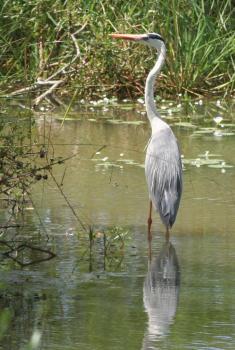 |
 |
Another large heron seen often in Yala National Park is the
Purple Heron Ardea purpurea. About the same size as the
grey Heron, is has a dark purple-tan (as opposed to white) neck and a
more purple-slate colored back than the Grey Heron. the Purple
Heron tends to be solitary and emits a croaking groan when disturbed.
They are found throughout India and Sri Lanka in open wetlands, marshes
and near rivers. |
|
The only ibis we saw in Sri Lanka was the Black-headed Ibis
Threskiornis melanocephalus. It is resident throughout much
of western India and the lowland perimeters of Sri Lanka. Like
other ibises, it has a long down-curved bill which it pushed into mud or
grasses to extract food -- both plant and animal. In breeding
season the adult develops chest plumes (seen in the photos to the
right), gray scapulars and long gray tertials. It lives in
colonies and has a vibrant grunt. |
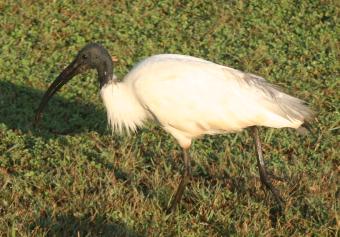 |
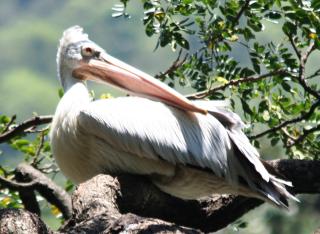 |
Head swiveled around, and casting an alert eye, this Gray or
Spot-Billed Pelican Pelecanus philippensis was not very
interested in leaving its perch in a sturdy tree on the edge of Kandy
Lake, in the town of Kandy, Sri Lanka. This bird is named for its
plumage which is more dirty-white than the White Pelican, and the bill
which shows small gray spots on the upper mandible on adult birds. These
pelicans can be found alone or in large colonies. They breed in
colonially in Sri Lanka and India and are found near large inland lakes
and coastal waters. (Kandy) |
| Cormorants are found on just about any body of water in the
sub-continent. These two were sunning themselves on the edge of
Kandy Lake, in the hill country of Sri Lanka. We're pretty sure the one
on the left is a Little Cormorant Phalacrocorax niger, but
the one on the right remains unidentified. Given its size, we can
guess it is the slightly larger Indian Cormorant or Indian
Shag Phalacrocorax fuscicollis, but the gular pouch beneath
the bill (with which one can distinguish one species from another) is
not visible, so we're not sure. All cormorants need to dry their
wings after swimming and they're often seen with wings spread wide in
the sun. They swim with their necks and head just out of the
water, then dive for fish which they capture in their long, strong bill.
(Kandy) (Photo by Chris Hacking) |
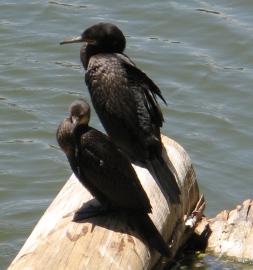 |
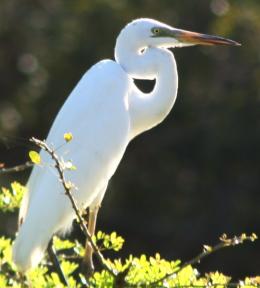 |
The Great Egret Casmerodius albus stands amazingly
large and white on the top branches of trees where it roosts. The
largest of all the egrets, this is a pure white bird with a black gape
that extends well past the eye. The normally yellow bill turns black
when breeding. This bird seems to be changing into breeding
plumage as the bill is only partially black, and it is showing the
characteristic light plumes on the lower back of a bird in breeding.
It can be found on rivers, lakes and mudflats, including inundated
cultivated fields. |
| Lesser Whistling Ducks Dendrocygna javanica tend to hang together in
large flocks on shallow, reed-covered ponds and marshes. They are
common throughout Sri Lanka and India. Also called the Lesser
Whistling Teal, these birds make a constant whistling sound "whi-whee"
usually while flying. Even their wings make a whistling sound.
They often roost in trees in the day, preferring to feed in dense reeds
at night. They nest in tree hollows, or deserted nests of other
birds. |
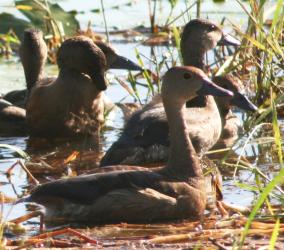 |
 |
Commonly called the Cattle Egret Bubulcus ibis for
their habit of sitting atop cattle or water buffalo to pick the insects
off them, these small (50 cm or 20 in) egrets are actually found in many
habitats. They might be seen in inundated fields, pond and
lakesides, or around human habitation or grassy fields. They nest
communally in trees and are usually silent except during breeding when
they make groaning and croaking sounds. The breeding adult wears a buffy-orange plumage on the head, neck and back; non-breeding adults are
pure white with a pale yellow bill and yellow-black legs. (Photo
by Sue Hacking) |
Up | Sri Lanka Birds | Sri Lanka Animals
| Sri Lanka Home
| Sri Lanka Newsletters
| Sri Lanka Cruising Info
West Indies Flora/Fauna | Venezuela Flora/Fauna | SW Caribbean Flora/Fauna | Galapagos Flora/Fauna | Fr. Polynesia Flora/Fauna | Tonga & Fiji Flora/Fauna | Australia Flora/Fauna | Southeast Asia Flora/Fauna | Sri Lanka Flora/Fauna | Madagascar Flora/Fauna | Marine Mammals
Top Level:
Home |
Destinations |
Cruising Info |
Underwater |
Boat Guests |
Ocelot |
Sue |
Jon |
Amanda |
Chris |
Site Map |
Make a Comment
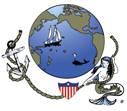 |
Lifetime
Commodores
of the
Seven Seas
Cruising
Association |
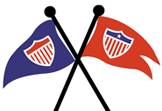 |
|
If our information is useful,
you can help by making a donation
|
Copyright © 2000‑ Contact:
Jon and Sue Hacking -- HackingFamily.com, svOcelot.com.
All rights reserved.














 Lured by the majestic display of a male Indian Peafowl
Pavo cristatus an interested hen (left) approaches in
Yala National Park. Although Peafowl have been introduced to many parts
of the world, here in Sri Lanka they still wander at will,
undomesticated and untamed in woodlands and forest. Peafowl rely more
on their legs than their wings to escape danger but do fly. In
fact they roost at night in trees where their large bodies appear ungainly
on small tree branches. Their call is a very loud "may-aw".
Lured by the majestic display of a male Indian Peafowl
Pavo cristatus an interested hen (left) approaches in
Yala National Park. Although Peafowl have been introduced to many parts
of the world, here in Sri Lanka they still wander at will,
undomesticated and untamed in woodlands and forest. Peafowl rely more
on their legs than their wings to escape danger but do fly. In
fact they roost at night in trees where their large bodies appear ungainly
on small tree branches. Their call is a very loud "may-aw".

 Probably the most beautiful of Sri Lanka's storks is the colorful
Painted Stork Mycteria leucocephal with its yellow, slightly
downcurved bill, coral-pink face and legs and black and white body with
pink tail feathers. Found in fresh water habitat throughout India and
Sri Lanka these large (93 cm or 34 inches) storks probe the silty, muddy
bottoms of marshes and ponds for frogs, mollusks and crabs.
Probably the most beautiful of Sri Lanka's storks is the colorful
Painted Stork Mycteria leucocephal with its yellow, slightly
downcurved bill, coral-pink face and legs and black and white body with
pink tail feathers. Found in fresh water habitat throughout India and
Sri Lanka these large (93 cm or 34 inches) storks probe the silty, muddy
bottoms of marshes and ponds for frogs, mollusks and crabs.
 Yala National Park is a fantastic place for viewing some of Sri
Lanka's 5 species of stork. Strutting along the road was a small
flock of Woolly Necked Storks (also known as White Necked Storks)
Ciconia episcopus. These large storks (up to 92 cm or 33 inches
tall) have black bodies with white "woolly" necks, black caps, bills and
wings, with red legs. They are not very gregarious, nor noisy. The
main sound they make is the sound of their mandibles clacking when their
heads are thrown back. They, like other storks, often soar on thermals.
Yala National Park is a fantastic place for viewing some of Sri
Lanka's 5 species of stork. Strutting along the road was a small
flock of Woolly Necked Storks (also known as White Necked Storks)
Ciconia episcopus. These large storks (up to 92 cm or 33 inches
tall) have black bodies with white "woolly" necks, black caps, bills and
wings, with red legs. They are not very gregarious, nor noisy. The
main sound they make is the sound of their mandibles clacking when their
heads are thrown back. They, like other storks, often soar on thermals.
 The Asian Openbill Stork is one of the smallest, but most
unusual of Sri Lanka's storks. It has an overall white plumage
(grayish when non-breeding) with black flight feathers, pale pink legs,
a gray head and a long gray bill that closes with a long gap (hence the
name "openbill"). Like other storks it makes large messy nests (left) in
trees, usually communally. After breeding these communities tend
to disperse. Openbills feed on frogs (right), mollusks and crabs.
The purpose of the gap in the closed mandibles is not known.
The Asian Openbill Stork is one of the smallest, but most
unusual of Sri Lanka's storks. It has an overall white plumage
(grayish when non-breeding) with black flight feathers, pale pink legs,
a gray head and a long gray bill that closes with a long gap (hence the
name "openbill"). Like other storks it makes large messy nests (left) in
trees, usually communally. After breeding these communities tend
to disperse. Openbills feed on frogs (right), mollusks and crabs.
The purpose of the gap in the closed mandibles is not known.










